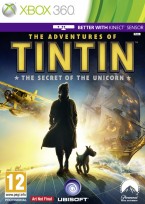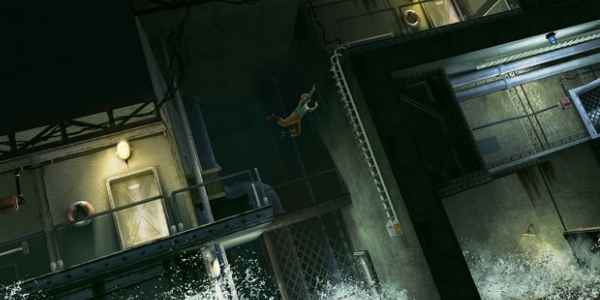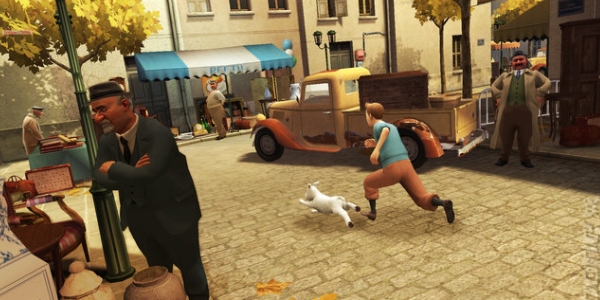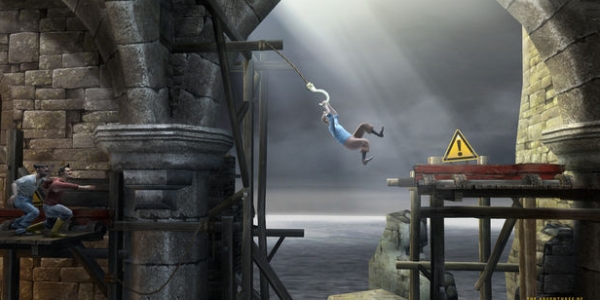The Adventures of Tintin: The Secret of the Unicorn is Ubisoft’s latest release to tie in with the recent movie of the same name. Although sticking to the same story, the Tintin game takes a different approach to your average movie game. Instead of opting for a monotonous 3D beat-‘em-up, Tintin chooses to tackle this cursed genre with a sidescrolling, 2D, puzzler style. Surprisingly, this unique take makes Tintin far better than most movie games on the market; it actually turns out pretty damn good.
Tintin’s gameplay revolves around minor puzzles, and sidescrolling, platforming action similar to that of Epic’s Shadow Complex. Navigating from room to room, you jump, climb, sprint and crawl often trying to escape or infiltrate. But, on your adventure, you will encounter various enemies and puzzles to keep the experience fresh and interesting. Being a game aimed at children, obviously there can’t be much violence, but Ubisoft manage to create the perfect non-violent combat suitable for any child. Tintin’s hand-to-hand combat consists plainly of basic punches, which ultimately result in the enemy humorously collapsing to the floor in an awkward position, with the classic ‘dizzy stars’ rotating around their head. But when it’s not hand to hand, it’s often using clichéd banana skins to slip the enemy, causing the same effect. Both comedic and appropriate combat, parents need not be worried about it badly influencing their kids.
When he’s not fighting, Tintin’s busy solving simple yet fun puzzled, being cautious not to overcomplicate things for the younger audience. Catching a nimble enemy with a key necessary for progression is a good example: it requires the player to think up a strategy, simply running at him head on won’t work since he’s much faster than Tintin, but the player must use their wits to successfully flank him. Other puzzles require Tintin to: sneak up on enemies guarding their front with oversized umbrellas, bouncing large beachballs to hit hidden switches, jumping up and around vents to get collectables, and many more. These puzzles add another element to the game which offers ab small challenge coupled with fun and exciting results.
On his adventures to find the secret of the Unicorn, Tintin will find himself in many different environments: pirate ships, a desert-y island, a big industrial ship and more. Each environment is radically different from the next, and each tailors its ‘resources’ around that aesthetic. For example, what was a nautical themed bottle on the industrial ship, would now be a bag of sand in the desert area. These areas all look great, although they all have the same basic features, Ubisoft have done a great job of making each one still seem different. Areas are colorful, vibrant and full of life, really pleasing on the eye, and sure to keep children ‘happy’.
As a simple 2D sidescroller, you’d think gameplay would quickly become repetitive, but surprisingly, it does not. Tintin is very clever in combating this often common flaw, by mixing in a few more gameplay styles and sections. Occasionally offering a break from the platforming, Tintin throws in a few 3D sections, and somewhat ‘minigames’ to bridge the gap between sections. These 3D sections just expanding on the already great gameplay, but only act as an exploration section, so unfortunately there’s no combat or puzzling. The minigames – also in 3D – link two areas together, showing the transportation between them. One of the first minigames is riding a motorcycle through the desert whilst being chased by bandits, also on motorcycles. Tintin is swapped between driving, and using a slingshot to off-road the enemy, both of which are equally fun. Not only do they keep the story ‘intact’, but these sections also maintain the game’s beautiful appearance. An appearance that – although not as good looking – stays in the same, great style as the movie.
Other sections of the game involve switching characters too. Players get the opportunity – at set points – to play as Snowy (Tintin’s dog) and Captain Haddock. Snowy’s sections often involve navigating through vents, sniffing out people (in the 3D sections), and collecting keys for Tintin to progress. Snowy looks and plays brilliantly, and his animations are so fluent, each of his sections – although short – are great to play. Haddock’s sections however mainly involve flashbacks to his ancestor’s on a pirate ship as it is invaded. The player needs to fend off attacking pirates with their sword. These sections are less fun, and much more difficult to complete:
Using Haddock’s sword is seriously difficult. To slash enemies, you use the right stick, and swing it in a back-forward motion – creating a ‘lunging’ effect. Not only does the sword not do what you wish, but it’s difficult to even create the initial motion, failing to do so usually results in no swing at all. After forcing yourself through the easy enemies, harder ones with shields are introduced, as is the parrying effect. Parrying somehow manages to make sword fighting even worse. The player needs to observe what the enemy is doing, and counteract their sword swing with a block, needing to position their sword in the correct direction to combat the incoming strike. It’s really difficult to notice which direction the enemy is swinging and so what you thought might be the right block, actually isn’t, but in hindsight; you still did it right…
The pirate sections, and very minor sections in the game demonstrate where Kinect functionality would be used to improve the gameplay. With no Kinect myself, I couldn’t test the functionality, but the sections appear to be made just for it, and so I’d expect it to be much more responsive and easy to play than as described above.
Tintin’s character’s are very memorable, and even if you’ve not seen the film or read the comics, the game does a great job of introducing them. Tintin features a lot of dialogue, even during gameplay, and the voice acting throughout is absolutely stellar. I’m not sure if the movie actors are used for the voices, but even if not, it’s a perfect representation of how you’d expect the characters to sound. Its story is equally strong, and although it doesn’t follow the movie script exactly, it makes appropriate twists to make it ‘fit’ with the game.
Overall, Tintin is the most different, and best movie game I’ve had the pleasure of playing. Its appropriately simple gameplay, memorable characters, and hilarious antics make it the perfect game for any child you’d like to introduce to gaming, or any child who enjoyed the movie. However some seemingly forced sections really pull the game down, and their failure to comply can become really frustrating. Definitely worth a buy for any parent who’d like their kids to grow up with gaming taste!
WIN THE TINTIN GAME ON PLAYSTATION 3:
We have a copy of the Tintin game on Playstation 3 to giveaway to one lucky reader. Entry is simple: retweet this tweet, and in the comments below, include your Twitter handle and tell us:
- If you’re a parent, why your child would love this game.
- If you’re not a parent, why your inner child would love this game.
The competition is open worldwide, so good luck to anyone who enters, and we’ll pick our favourite answer from the comments (who has also retweeted) on Saturday!













